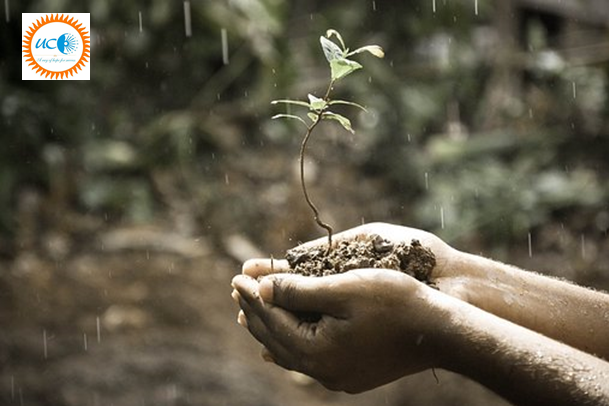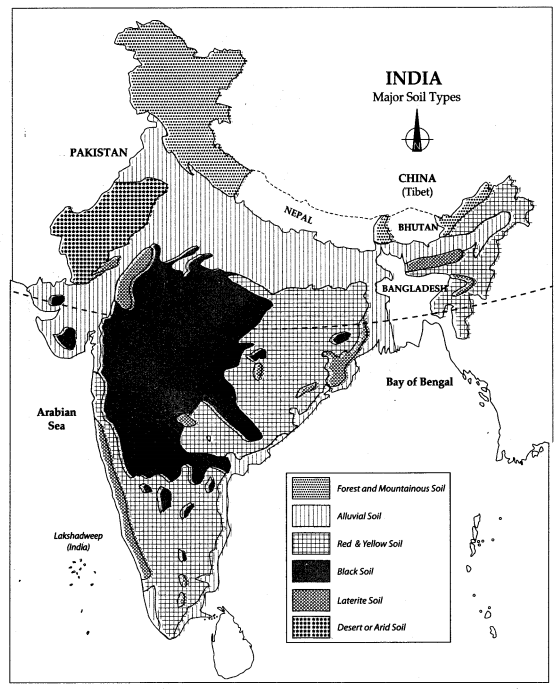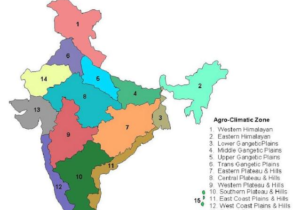India has diversity of soil. Explain the factors responsible of its Pedogenesis.(150 Words)
Begin by
- Start by mentioning about the diversity of soils in India and their profile across major regions they are found in.
- Talk about reasons for diversity in the Indian soil profile and some important characteristics and crops sown in each soil briefly.
- A small map of major soil regions of India could be drawn for better presentation purpose.
- Then in detail mention about the various factors responsible for (Pedogenesis) soil formation in India.
- Explain about factors such as Parent Material, Relief. Climate and Natural Vegetation. Substantiate your answer with relevant examples.
- Complete the answer by stressing on the importance of diversity in the soil profile of India.
Introduction:
- Pedogenesis: The process of soil formation.
- Pedogenesis is influenced by organisms present in the soil, climatic conditions, weathering, and other biogeochemical activities.
- India has varied relief features, landforms, climatic realms and vegetation types. These have contributed in the development of various types of soils in India.
Major groups:
- Alluvial soils,
- Black soils,
- Red soils,
- Laterite and Lateritic soils,
- Forest and Mountain soils,
- Arid and Desert soils,
- Saline and Alkaline soils and
- Peaty and Marshy soils.
Body:
Factors that influence soil formation in Indian Conditions
- Parent Material
- Relief
- Climate
- Natural Vegetation
Parent Material
- Parent materials are the rocks that soils are created from.
- The parent material, in most circumstances, determines the color, mineral composition, and texture of the soil.
- The soil created may or may not have the same physical qualities as the parent rock in various circumstances.
- Climatic conditions cause chemical changes in the soil, which impact its physical qualities.
- The weathering process is exposed to the surface rocks.
- The rocks are turned into fine grains in this process, which serve as a foundation for the development of soil.
- In Indian conditions, the parent material is classified as follows:
- Ancient crystalline and metamorphic rocks
- Cuddapah and Vindhyan rocks
- Gondwana rocks
- Deccan basalts
- Tertiary and Mesozoic sedimentary rocks of extra peninsular India {Rock System}
Climate
- The most essential components in soil formation are temperature and rainfall.
- They determine the effectiveness of the parent material’s weathering, the amount of water that seeps through the soil, and the kind of microorganisms that live there.
- In the same environment, two different parent materials may produce the same soil. Similarly, the same parent material can yield two distinct soil types in two distinct climates.
- The crystalline granites create laterite soil in the monsoonal region’s more damp areas and non-laterite soil in the drier areas.
- Regardless of the parent rock, hot summers, and limited rainfall produce black soil, as seen in some places of Tamil Nadu.
- Granite and sandstone both give birth to sandy soil in Rajasthan’s arid environment.
- Evaporation always exceeds precipitation in dry and semi-arid environments.
- There is minimal vegetation, and the soils are severely deficient in humus. As a result, the soils are always pale in color.
- Excessive evaporation causes soils in Rajasthan and the surrounding dry and semi-arid regions to accumulate lime.
- As a result, the soil is pedocal [Pedocal is a subdivision of the zonal soil order. It’s a type of dirt that grows in semiarid and arid climates. It has a high calcium carbonate content and a low soil organic matter content].
- The process of vegetation breakdown is very slow in the Himalayan region’s frigid weather, and the soils are acidic.
Relief
- Relief, or the configuration or shape of the ground surface, has an impact on soil formation.
- Soil horizons are dense on moderate slopes and thin on steep slopes in general.
- This is due to the fact that erosion removes soil more quickly on steeper slopes.
- Furthermore, slopes facing away from the Sun are shielded from direct sunlight, resulting in cooler, moister soils.
- Direct sun rays reach slopes towards the Sun, raising soil temperatures and increasing evapotranspiration.
- The water that reaches the soil surface is redistributed by topography.
- Runoff from the uplands causes wetter conditions in the lowlands, including salty sloughs and organic soils in some circumstances.
- Thus, topography affects soil processes, soil distribution, and the type of plants at the site as a redistributor of climate variables.
Organisms
- The impact of living plants and animals, as well as their nonliving organic products, on soil, is significant.
- Plant roots mix and disturb the soil as they grow, and they provide organic material straight to the topsoil strata.
- Many different species of bacteria, as well as burrowing mammals, live in the soil.
- Earthworms constantly rework the soil by digging and bypassing it through their intestinal tracts.
- Larger, tube-like entrances are made by moles, gophers, rabbits, badgers, prairie dogs, and other burrowing creatures.
- Earthworms’ cultivating and mixing actions are extremely beneficial in terms of enhancing the structure, increasing fertility, reducing the risk of accelerated erosion, and deepening the soil profile.
- The existence of many well-nourished earthworms is always an indicator of productive, or potentially productive, soil, as evidenced by their presence.
Human Activity
- The physical and chemical composition of the soil is also influenced by human activity.
- Clearing native plants for crops can cause erosion by eliminating organic matter-rich higher layers.
- For ages, vast swaths of agricultural soil have been ploughed and planted. As a result, these agricultural soils’ structure and content have changed dramatically.
- These modified soils are frequently acknowledged as different soil classifications with equal importance to natural soils.
Conclusion
Soil is one of the most significant components of an ecosystem, containing both biotic and abiotic constituents. Soil contains both living and dead plant and animal debris, as well as air, water, and minerals. Phosphorus, potassium, and nitrogen gas are the most important minerals present in the soil that encourage plant growth.







